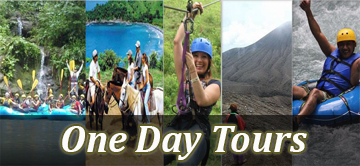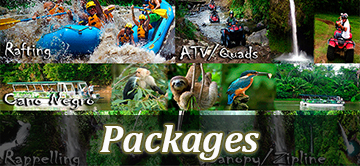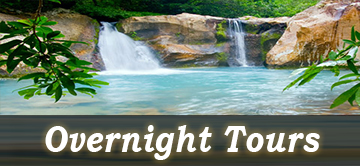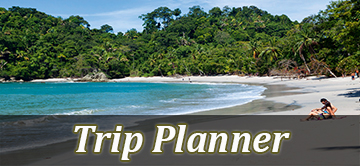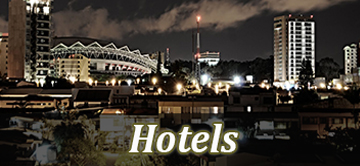The northern region is known for its seasonal rains, which have become a local problem due to rivers and lakes overgrow, turning the area into a wet swamp.
Farmers work the land with corn, rice, beans and sugar cane. From the sugar cane comes the national alcoholic drink the “Cacique” (known as ‘guaro’). This is the least visited region in the country, only visited by tourists for daily tours not for long stays
Vara Blanca
Vara Blanca is on the way to Poas and Barva volcanoes. It is the perfect landscape to take pictures, high mountains filled with trees and green colors. About 8 km from Vara Blanca, you will find the La Paz River and its surrounding waterfalls.
San Carlos Dock
San Carlos dock is famous for its huge sugar lands and its important navigation. It is highly recommended to drive attentively in the area as tired truck drivers stop to eat and rest, and park their big trucks on the road aside the dock.
Venado Caves
These caves were discovered in 1945 when a farmer accidently fell into a hole on the ground and found himself in the Venado Caves. This area is made of soft, malleable limestone and is home to spiders, bats and eye fishes. It’s important to take lights, helmets and a good shower afterwards. Outside the caves you will find a grocery store.
Upala
It is located 9 km south of Nicaragua’s border, on the northwestern corner. Upala is a small town with 15.000 inhabitants. This is the country’s main zone for cattle and rice production. Many businesspeople visit this zone for exchanging ideas and commercialize. Nowadays, people drive through this area to get to Caño Negro and Los Chiles.
Caño Negro Wildlife National Refuge
This refuge has a 102 km2 area and its beautiful landscapes are defined by the Rio Frio. Caño Negro is popular for its fishing activities (although it’s closed from April to July) and for being a migratory place for birds.
Los Chiles
It is 70 km north of the San Carlos dock, very close to the Nicaraguan border. The main road is surrounded by sugar cane plantations. Their main activities are the farming and fishing, due to its proximity to the San Juan River.
Los Chiles is a popular touristic destination, as well as a pass-through town to many other attractive regions.
Northern RegionPuerto Viejo, Sarapiqui
Sarapiqui is the number 10 canton in the Heredia province and is located near Rio Frio. The main agricultural activities in the region are livestock, maize, cocoa, citrus, bananas, palm trees, fruit trees and coffee plantations. Southern Sarapiqui is located partially in the Forest Reserve Central Volcanic Range.
The Sarapiqui River has a relevant history to Costa Rica, mainly for two reasons:
It was the first commerce connection between Costa Rica and Europe.
It played a very important role in the defense of national sovereignty, when the filibusters, commanded by William Walker, arrived in Costa Rica by the Sarapiqui in 1856.
La Virgen, a small town inside Sarapiqui is another well-known attraction. People say the Virgin used to appear to religious people, making it a popular place for visitors to come and pray. Sarapiqui also has beautiful landscapes and entertaining local activities.
South of Puerto Viejo de Sarapiqui
Thousands of banana plantations through make up the Caribbean coast’s scenery. It is a very accessible zone with 3 overland routes:
1) The traditional route or path of the heroes (Rod White), where you can observe the San Fernando and La Paz waterfalls, mountains, rivers and volcanoes.
2) The Braulio Carillo National Park road, an area of exuberant wildlife and landscapes.
3) Through San Carlos, an agricultural region with pineapple crops, palms and ornamental plants.
La Selva Biological Station
This place is well equipped with biological laboratories, experimental plots and an extensive library. Visitors are mainly scientists and students. It offers a hotel especially designed for the needs of its visitors.
Heliconia Island
It is best known for its serenity thanks to its beautiful gardens. This place was created in 1992 by Tim Ryan, an art and design teacher from New York. It has more than 2 hectares of tropical flowers, plants and trees, over 80 species of helicons, more than 228 species of birds and four resident species of monkeys.
Rara Avis
It has 1335 hectares and it’s located in high altitude tropical rain forest. This place was founded by Amos Bien, an American biology student, in 1977. This reserve borders the Braulio Carillo National Park, where you can enjoy watching birds and the high waterfalls. Accommodations offered in the area are lovely and rustic.
Arenal Route
This route starts in Ciudad Quesada. It is not as used by travelers, since the opening of the Inter-American Highway.
Volcanoes and rainforests are part of the road’s landscapes, as well as small towns such as Tilaran and Nuevo Arenal. Important restaurants, luxury hotels and art galleries can also be found along the way.
Ciudad Quesada- San Carlos
San Carlos is the tenth canton in the Northern RegionAlajuela province. Most of its population inhabits in Quesada City, its main town. It has an extension of 3,347 km, making Ciudad Quesada one of the largest cities in the country, surpassing in size the cities of Cartago and Heredia.
The city was founded in 1911 and it consists of 13 districts.
1-Quesada
2-Florencia
3-Buenavista
4-Aguas Zarcas
5-Venecia
6-Pital
7-Fortuna
8-La Tigra
9-Palmera
10-Venado
11-Cutris
12-Monterrey
13-Pocosol
San Carlos is considered to be part of the countryside of Costa Rica. It is the main town in the North Huetar Region and is made up by others cantons such as Los Chiles, Guatuso, Upala, Sarapiqui and Tilaran.
La Fortuna
It is a relaxing place to stay for a few days. Waterfalls and hot springs surround this area and is very easy to get around town, since thousands of tour operators are happy to provide you with their services.
La Fortuna is one of the most visited destinations and has many natural attractions for tourists, thanks to its proximity to the majestic Arenal Volcano.
Arenal Volcano National Park
It’s located in the central part of the country and is part of the Arenal-Tilaran Conservation Area. The park surrounds the Arenal Volcano, the most active volcano in the country. The Arenal Lake has the largest hydroelectricity project in the country.
There is also a second volcano in the park named Chato, and a lagoon within the crater, called Chato’s Mount.
Arenal Lagoon Area
It is located 18km west of la Fortuna. This lake is the largest in the country with 88 km2. It was created by an enlarging existing lake with the same name, with the completion of a dam in 1979. It is located near the Arenal Volcano and the Monteverde Cloud Forest.
Lake Arenal is the key driver in a nationwide hydroelectric project that currently produces most of the electricity for the entire country. Water depth generally varies between 100 and 200 feet. The communities of “old” Arenal were submerged by the expanded lake.
From November through April, the dependable strong winds attract windsurfers to its western end.
Real estate around Arenal Lake region is growing, due to the low prices compared to beach fronts and the ocean view properties in the country.
There are two species of fish in the lake, the Machaca and the Bass. Birds’ species found in the area are the hummingbirds and the woodpeckers

